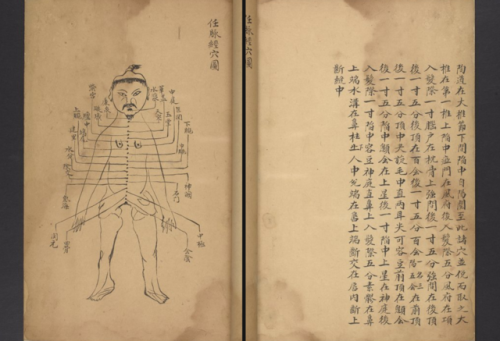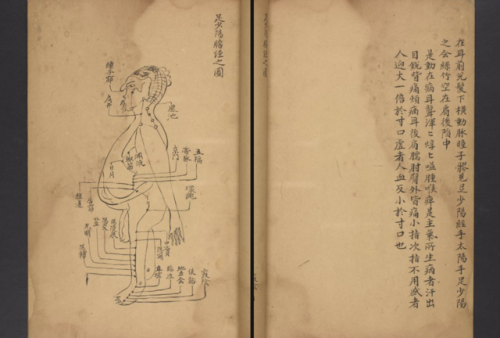In 1992, A Man Named Wu Anai, Near A Chinese Village In Longyou County, Based On A Hunch, Began To Pump




In 1992, a man named Wu Anai, near a Chinese village in Longyou County, based on a hunch, began to pump water out of a pond in his village. Anai believed the pond was not natural, nor was it infinitely deep as the local lore went, and he decided to prove it. He convinced some of his villagers and together they bought a water pump and began to siphon water out of the pond. After 17 days of pumping, the water level fell enough to reveal the flooded entrance to an ancient, man-made cave!
The cave has twenty-four rooms. There are pillars, staircases, and high ceilings over 30 meters (98 ft!) up. The work was done by humans, we know, because they left visible chisel marks in uniform bands of parallel groves. With over 30,000 square meters of space, all meticulously chiseled, this would have been a huge undertaking. Even if people were simply enlarging caves which already existed, it would still have required a lot of manpower working in a coordinated system for a long period of time.
Since the project would have been so large, it seems amazing that no record of it exists in China’s extensive written history. But there is not a word. Based on the cave alone, it is estimated to have been completed around 200 BCE, near the Qin Dynasty or Han Dynasties.
More Posts from Philosophical-amoeba and Others
Computer Science/Engineering Masterpost
Online lectures:
Discrete Mathematics (x) (x) (x) (x) (x)
Data Structures (x) (x) (x) (x) (and Object Oriented Programming (x) )
Software Engineering (x)
Database (x)
Operating Systems (x) (x) (x) (x) (x) (x) (x)
Structure and Interpretation of Computer Programs (x)
Computer Architecture (x)
Programming (x) (x) (x) (x) (x) (x) (x)
Linear Algebra (x) (x) (x)
Artificial Intelligence (x) (x)
Algorithms (x)
Calculus (x) (x) (x)
Tutorials (programming) and other online resources:
Programming languages online tutorials and Computer Science/Engineering online courses
Java tutorial
Java, C, C++ tutorials
Memory Management in C
Pointers in C/C++
Algorithms
Genetic Algorithms
Websites for learning and tools:
Stack Overflow
Khan Academy
Mathway
Recommended books:
Computer organization and design: the hardware/software interface. David A.Patterson & John L. Hennessy.
Artificial intelligence: a modern approac. Stuart J. Russel & Peter Norvig.
Database systems: the complete book. Hector Garcia-Molina, Jeffrey D. Ullman, Jennifer Widom.
Algorithms: a functional programming approach. Fethi Rabbi & Guy Lapalme.
Data Structures & Algorithms in Java: Michael T. Goodrich & Roberto Tamassia.
The C programming language: Kernighan, D. & Ritchie.
Operating System Concepts: Avi Silberschatz, Peter Baer Galvin, Greg Gagne.
Study Tips:
How to Study
Exam Tips for Computer Science
Top 10 Tips For Computer Science Students
Study Skills: Ace Your Computing Science Courses
How to study for Computer Science exams
How to be a successful Computer Science student
Writing in Sciences, Mathematics and Engineering:
Writing a Technical Report
Writing in the Sciences (Stanford online course)
Writing in Mathematics, Statistics and Computer Science Courses
Are Complex Numbers Really Numbers?
If you look through definitions of “number” most will say that numbers are used to represent quantities (amounts or measures). Whole numbers 0, 1, 2, 3, … are probably the first numbers that come to mind and they are often used to count things like say how may watermelons jimmy has. But when quantifying things like money, whole numbers are not always enough and so we have rational numbers (which include the whole numbers but also fractions and numbers with finite or repeating decimal expansions). Yet, sometimes even these numbers are not enough to express certain quantities. Pi, for example, is not a rational number but is certainly a number as it represents the quantity that is the ratio of a circle’s circumference to its diameter. It can be shown that the number pi has an infinite decimal expansion with no repeating patterns, and so a number like pi is called an irrational number. (Because they are silly? Although at first some thought so, the term irrational just means not rational.) More specifically, pi is a transcendental number as it is not the root of any polynomial. (Transcendental, because they transcend the usual notion of number? Idk. Again, strange names.) So, the rational numbers were extended to the real numbers to include both rational and irrational numbers. Either way, we see that both rational and irrational numbers are truly numbers since they can be used to represent quantities.
What about complex numbers though? Are they really numbers, or do people just call them “numbers”? So, we should ask, can complex numbers represent some amount or measure of something? Can jimmy have i watermelons? No, but jimmy can’t really have pi watermelons either and pi is a number. Jimmy may have a watermelon that weighs pi pounds though (the only way to know this would be if jimmy had a scale with infinite accuracy, which, turns out, he does). Okay but can jimmy have a watermelon weighing i pounds? That doesn’t seem to make sense. To see if complex numbers can represent quantities we need to elaborate on what complex numbers are exactly.
The complex numbers are the real numbers extended to include the square root of negative 1 (i) and all its multiples. They have the form a+bi where a and b are real numbers. i is called an imaginary number (named imaginary because, i is not a real number, but this implies numbers like i are somehow not “real”, in the usual English sense of the word (are any numbers really “real”?) again, with the names). What truly makes complex numbers different than the other numbers we have discussed is that they “live” in 2 dimensions (the complex plane); complex numbers (e.g., 7+2i) have a real part (7) and an imaginary part (2i). While real numbers (which include whole, rational, and irrational numbers) “live” in one dimension (they can be found anywhere on the number line).
So, a complex number is a sort of two-dimensional quantity, it has a real measure and an imaginary measure. This makes them strange as numbers. We know 12 is bigger than 11 and that there are a bunch of numbers in-between 11 and 12, but which is bigger 2-8i or 3+i? Complex numbers cannot be compared in the same way i.e., there is no way to order complex numbers from smallest to largest.
These properties make complex numbers more abstract than typical numbers we encounter day to day. Nevertheless, “complex numbers are useful abstract quantities that can be used in calculations and result in physically meaningful solutions. However, recognition of this fact is one that took a long time for mathematicians to accept.”—Wolfram MathWorld http://mathworld.wolfram.com/ComplexNumber.html
Aphasia: The disorder that makes you lose your words

It’s hard to imagine being unable to turn thoughts into words. But, if the delicate web of language networks in your brain became disrupted by stroke, illness or trauma, you could find yourself truly at a loss for words. This disorder, called “aphasia,” can impair all aspects of communication. Approximately 1 million people in the U.S. alone suffer from aphasia, with an estimated 80,000 new cases per year. About one-third of stroke survivors suffer from aphasia, making it more prevalent than Parkinson’s disease or multiple sclerosis, yet less widely known.

There are several types of aphasia, grouped into two categories: fluent (or “receptive”) aphasia and non-fluent (or “expressive”) aphasia.

People with fluent aphasia may have normal vocal inflection, but use words that lack meaning. They have difficulty comprehending the speech of others and are frequently unable to recognize their own speech errors.

People with non-fluent aphasia, on the other hand, may have good comprehension, but will experience long hesitations between words and make grammatical errors. We all have that “tip-of-the-tongue” feeling from time to time when we can’t think of a word. But having aphasia can make it hard to name simple everyday objects. Even reading and writing can be difficult and frustrating.

It’s important to remember that aphasia does not signify a loss in intelligence. People who have aphasia know what they want to say, but can’t always get their words to come out correctly. They may unintentionally use substitutions, called “paraphasias” – switching related words, like saying dog for cat, or words that sound similar, such as house for horse. Sometimes their words may even be unrecognizable.

So, how does this language-loss happen? The human brain has two hemispheres. In most people, the left hemisphere governs language. We know this because in 1861, the physician Paul Broca studied a patient who lost the ability to use all but a single word: “tan.” During a postmortem study of that patient’s brain, Broca discovered a large lesion in the left hemisphere, now known as “Broca’s area.” Scientists today believe that Broca’s area is responsible in part for naming objects and coordinating the muscles involved in speech. Behind Broca’s area is Wernicke’s area, near the auditory cortex. That’s where the brain attaches meaning to speech sounds. Damage to Wernicke’s area impairs the brain’s ability to comprehend language. Aphasia is caused by injury to one or both of these specialized language areas.
Fortunately, there are other areas of the brain which support these language centers and can assist with communication. Even brain areas that control movement are connected to language. Our other hemisphere contributes to language too, enhancing the rhythm and intonation of our speech. These non-language areas sometimes assist people with aphasia when communication is difficult.

However, when aphasia is acquired from a stroke or brain trauma, language improvement may be achieved through speech therapy. Our brain’s ability to repair itself, known as “brain plasticity,” permits areas surrounding a brain lesion to take over some functions during the recovery process. Scientists have been conducting experiments using new forms of technology, which they believe may encourage brain plasticity in people with aphasia.
Meanwhile, many people with aphasia remain isolated, afraid that others won’t understand them or give them extra time to speak. By offering them the time and flexibility to communicate in whatever way they can, you can help open the door to language again, moving beyond the limitations of aphasia.

BHL Book Feature: The Birds of Singapore Island
Our book feature this week is The Birds of Singapore Island (1927), co-authored by John Alexander Strachey Bucknill and Frederick Nutter Chase with SciArt by Gerald Aylmer Levett-Yeats, and published by the Raffles Museum. This work is the first book on the birds of Singapore!
Our featured illustration is a Greater Racket-tailed Drongo (Dicrurus paradiseus platurus). This book is written in an informal, non-scientific style to appeal to tourists and bird enthusiasts, and the description of the Greater Racket-tailed Drongo is a good example of this writing style.

All this week, we will be sharing several of the 31 plates from The Birds of Singapore Island, which was digitized for BHL by National Library Board, Singapore. You can view all of the plates from this work in our Flickr album, and check out our blog post, which was written by Ong Eng Chuan, Senior Librarian of the National Library Board, Singapore.
5 NASA Software Codes You Can Download – For Free!
One of the biggest steps of any mission starts right here on Earth at a computer desk – NASA runs on software, period. Rovers can’t move, spacecraft can’t fly, even rockets can’t blast off without the software codes that run them all.
We’ve compiled hundreds of these powerful codes into one location at software.nasa.gov. And guess what? You can start downloading them right now for free! Here are just a few you can use:
1. TetrUSS (Tetrahedral Unstructured Software System)
TetrUSS has been used extensively for space launch vehicle analysis and design, like on the Space Launch System, which is planned to take humans to Mars.

You really could say it’s helping us to “blast off.” Outside of NASA, this software has been used to analyze Mars planetary entry vehicles, ballistics and even high-altitude sky diver aerodynamics. Basically if anything has moved through any planetary atmosphere, this software has played a role.
2. KNIFE (part of the FUN3D software and released as a package)
The name may be a bit intimidating, but with good reason – KNIFE packs a powerful punch.

It was created to help us learn more about the sonic booms that resonate when planes break the sound barrier, but it has also helped develop green energy sources such as wind turbines and techniques to minimize drag for long-haul trucking. Maybe we should re-name this versatile and handy code, “Swiss Army KNIFE?”
3. Cart3D (Automated Triangle Geometry Processing for Surface Modeling and Cartesian Grid Generation)
If software codes went to high school, Cart3D would be Prom Queen. This software is so popular, it is being used in almost every mission area here at NASA.

Engineers and scientists are currently using it to model everything from advanced drones to quieter supersonic aircraft.
4. FACET (Future Air Traffic Management Concepts Evaluation Tool)
Frequent flyers: this may be your favorite code without even knowing it. FACET was developed to evaluate futuristic concepts in air traffic management, and it has served as a testbed for assessing today’s regular operations.

To sum it up, this software code helps airports keep planes organized in the air and on the ground.
5. GIPSY-OASIS
GIPSY-OASIS is part of the GPS system to end all GPS systems. It’s so accurate, John Deere used it to help create self-driving tractors.

How? John Deere already had a navigation system in the works, but it could only be used in certain parts of the world.

Our ground stations are all across the globe, and our software ensures accuracy down to a few inches. And so, a new breed of tractor was born! Did we mention this software is free?
These are just a few examples of the software NASA has available for free public and consumer use. To browse the catalog online, check out software.nasa.gov.
Make sure to follow us on Tumblr for your regular dose of space: http://nasa.tumblr.com





This week, we’re taking a look at manuscripts having to do with health, medicine, and human physiology specifically focusing on how bodies are displayed in manuscript illuminations or diagrams across different cultures.
LJS 389 shown above, is a 14th century Chinese treatise on the anatomy, physiology, and pathology of blood vessels titled Shi si jing fa hui. The manuscript is made from bamboo paper and the diagrams and kaishu script are written with black ink. Focus on the diagrams of the bodies and stay tuned this week to see not only how the details and forms of these depictions change from culture to culture, but also the mediums with which these manuscripts are created.
The full LJS 389 manuscript filled with more diagrams can be found on Openn: http://openn.library.upenn.edu/Data/0001/html/ljs389.html
and Penn In Hand: http://hdl.library.upenn.edu/1017/d/medren/4824235
A Cry for Help.
I seek the Word of @cranquis and the Word of @wayfaringmd on proper tick removal technique. Where I live we’re being warned that populations will be high this summer and that 50% of the ticks are testing positive for Lyme disease. Between the cat, the dog, and three kids I know I’m going to have to deal with them soon.
I’m hearing so many conflicting things, even from MDs. Burn them with a match? Pour olive oil on them? I thought we weren’t supposed to do that stuff? Should I buy that fancy tick remover thing? Or does each one require a trip to the office? Help me Crayfaring, you’re my only hope! 😩

-
 deacita liked this · 1 year ago
deacita liked this · 1 year ago -
 craftyphantombanana liked this · 1 year ago
craftyphantombanana liked this · 1 year ago -
 scratchface liked this · 1 year ago
scratchface liked this · 1 year ago -
 kowai8potato liked this · 1 year ago
kowai8potato liked this · 1 year ago -
 bearcat-screms reblogged this · 1 year ago
bearcat-screms reblogged this · 1 year ago -
 bearcat-screms liked this · 1 year ago
bearcat-screms liked this · 1 year ago -
 bluelightning42 reblogged this · 1 year ago
bluelightning42 reblogged this · 1 year ago -
 bluelightning42 liked this · 1 year ago
bluelightning42 liked this · 1 year ago -
 archaeologyprehistoricstones reblogged this · 2 years ago
archaeologyprehistoricstones reblogged this · 2 years ago -
 liquidsnot reblogged this · 2 years ago
liquidsnot reblogged this · 2 years ago -
 underheavenunderworld reblogged this · 2 years ago
underheavenunderworld reblogged this · 2 years ago -
 worstcasescenariolullaby liked this · 3 years ago
worstcasescenariolullaby liked this · 3 years ago -
 wolfeofchaos liked this · 3 years ago
wolfeofchaos liked this · 3 years ago -
 culturalspartanpw reblogged this · 3 years ago
culturalspartanpw reblogged this · 3 years ago -
 jinxedbabbles liked this · 3 years ago
jinxedbabbles liked this · 3 years ago -
 heartsmourne reblogged this · 3 years ago
heartsmourne reblogged this · 3 years ago -
 mc1303 liked this · 3 years ago
mc1303 liked this · 3 years ago -
 adoneus liked this · 3 years ago
adoneus liked this · 3 years ago -
 messiahcomplexe liked this · 3 years ago
messiahcomplexe liked this · 3 years ago -
 hrh-gwen reblogged this · 3 years ago
hrh-gwen reblogged this · 3 years ago -
 robin-goodfellow reblogged this · 3 years ago
robin-goodfellow reblogged this · 3 years ago -
 allcryptids liked this · 3 years ago
allcryptids liked this · 3 years ago -
 palpatinecalmlypooping liked this · 3 years ago
palpatinecalmlypooping liked this · 3 years ago -
 primasveraas liked this · 3 years ago
primasveraas liked this · 3 years ago -
 spoookythecat liked this · 3 years ago
spoookythecat liked this · 3 years ago -
 electrictouchfeaturingfalloutboy reblogged this · 3 years ago
electrictouchfeaturingfalloutboy reblogged this · 3 years ago -
 aelizel liked this · 3 years ago
aelizel liked this · 3 years ago -
 naberiie reblogged this · 3 years ago
naberiie reblogged this · 3 years ago -
 noctuatacita reblogged this · 3 years ago
noctuatacita reblogged this · 3 years ago -
 namelyuntitled liked this · 3 years ago
namelyuntitled liked this · 3 years ago -
 siristaci reblogged this · 3 years ago
siristaci reblogged this · 3 years ago -
 jango-tango reblogged this · 3 years ago
jango-tango reblogged this · 3 years ago -
 jango-tango liked this · 3 years ago
jango-tango liked this · 3 years ago -
 su-art-n-stuff liked this · 3 years ago
su-art-n-stuff liked this · 3 years ago -
 antimattercontainment reblogged this · 3 years ago
antimattercontainment reblogged this · 3 years ago -
 kcajrebmul liked this · 3 years ago
kcajrebmul liked this · 3 years ago -
 the-nut-queen liked this · 3 years ago
the-nut-queen liked this · 3 years ago -
 veechyoda liked this · 3 years ago
veechyoda liked this · 3 years ago -
 schiefertafel liked this · 3 years ago
schiefertafel liked this · 3 years ago -
 marrowmerrow liked this · 3 years ago
marrowmerrow liked this · 3 years ago -
 samaralclark reblogged this · 3 years ago
samaralclark reblogged this · 3 years ago
A reblog of nerdy and quirky stuff that pique my interest.
291 posts